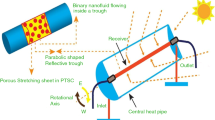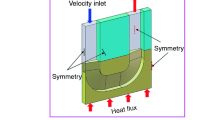Abstract
Temperature and acid droplet size effects on the rate of acid neutralization by Marine Cylinder Lubricants were investigated by using a heating-capillary video microscopy. The neutralization experiments were performed inside a ∼200-μm capillary micro-reactor and the progress of reaction was recorded in real time. Increasing temperature dramatically impacted on the neutralization rate. While the effect of acid droplet size was negligible initially, it might affect the rate as well when a droplet got smaller than a certain level.



Similar content being viewed by others
References
Hosonuma K., Tamura K. (1984) Sekiyu Gakkaishi 27(2):108
J.-P. Roman, New method of measurement in thin film of the neutralization ability of marine lubricants for low-speed and medium-speed diesel engines, Proc. of the 22nd CIMAC Internal. Congress on Combustion Engines, Copenhagen, DK (1998) CIMAC Technical papers & Recommendations
Hone D.C., Robinson B.H., Steytler D.C., Glyde R.W., Galsworthy J.R. (2000) Langmuir 16(2):340
Wu R.C., Papadopoulos K.D. Campbell C.B. (2000) AIChE. J. 46(7):1471
Wu R.C., Campbell C.B., Papadopoulos K.D. (2000) Ind. Eng. Chem. Res. 39(10):3926
Fu J., Lu Y., Campbell C.B., Papadopoulos K.D. (2005) Optical Microscopy inside a Heating Capillary. Ind. Eng. Chem. Res. 44(5):1199
Stott F.H., Macdonald A.G. (1988) Wear 122(3):343
ASTM D2896-05. Standard Test Method for Base Number of Petroleum Products by Potentiometric Perchloric Acid Titration; ASTM International
Lemaire B., Bothorel P. (1980) Macromolecules 13(2):311
J. Fu, Y. Lu, C.B. Campbell and K.D. Papadopoulos, Ind. Eng. Chem. Res. (2006) in press.
Wu R.C., Papadopoulos K.D., Campbell C.B. (1999) AIChE. J. 45(9):2011
Krapivsky P.L., Ben-Naim E (1994) J. Chem. Phys. 100(9):6778
Wackenhut M. Herrmann H. (2003) Phy. Rev. E: Stat. Nonlin.Soft Matter Phys. 68(4–1):041303/1
Galsworthy J., Hammond S., Hone D. (2000) Curr. Opin. Colloid Interface Sci. 5(5–6):274
Acknowledgments
This research was funded by LEQSF of the Louisiana Board of Regents under its ITRS program, Chevron Oronite Company LLC, and Tulane Institute for Macromolecular Engineering and Science (TIMES).
Author information
Authors and Affiliations
Corresponding author
Rights and permissions
About this article
Cite this article
Fu, J., Lu, Y., Campbell, C.B. et al. Temperature and acid droplet size effects in acid neutralization of marine cylinder lubricants. Tribol Lett 22, 221–225 (2006). https://doi.org/10.1007/s11249-006-9082-z
Received:
Accepted:
Published:
Issue Date:
DOI: https://doi.org/10.1007/s11249-006-9082-z




